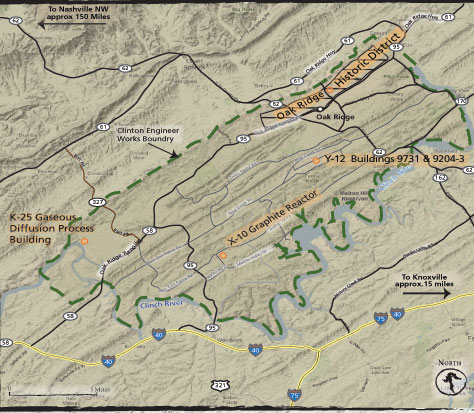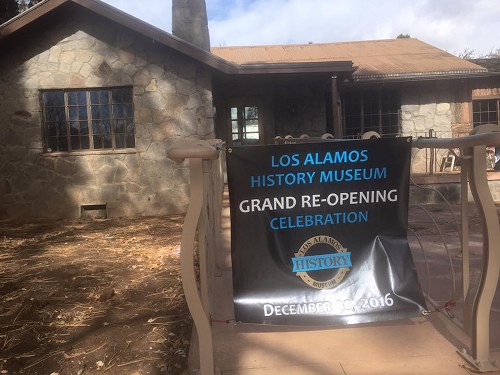
The late Bill Wilcox by the International Friendship Bell in Oak Ridge. (Courtesy of Friends of the International Friendship Bell via Atomic Heritage Foundation)
Note: This story was last updated at 12 p.m. Dec. 8.
More than 80,000 people have visited the three sites of the Manhattan Project National Historical Park, which includes Oak Ridge, according to a nonprofit organization in Washington, D.C.
Besides Oak Ridge, the park includes Hanford, Washington, and Los Alamos, New Mexico.
In Oak Ridge, the Manhattan Project National Historical Park has a volunteer or ranger at the American Museum of Science and Energy in Oak Ridge when the museum is open. The park also has activities. For example, there is a program on secrecy, security, and spies at the Oak Ridge Turnpike Gatehouse in west Oak Ridge on Saturday, December 17. And the park, in partnership with the Children’s Museum of Oak Ridge, will be featuring a Parks in Focus photography exhibit during the month of December. The photography exhibit is located in the Imagination Gallery at the museum located at 461 West Outer Drive.
Also, a virtual tour of the K-25 Building can be found at the new K-25 Virtual Museum website. And from March to November, admission to AMSE includes a three-hour bus tour of the Oak Ridge Reservation, including the X-10 Graphite Reactor at Oak Ridge National Laboratory, New Bethel Church at ORNL, the visitor overlook at the East Tennessee Technology Park (former home to the K-25 gaseous diffusion building), and Y-12 New Hope History Center.
The nonprofit Atomic Heritage Foundation said the three sites of the Manhattan Project park have received more than 80,000 visitors so far in 2016, according to National Park Service data. The Park Service and the local communities are expecting an influx of visitors in the coming years with projections ranging in the hundreds of thousands in five years, the Atomic Heritage Foundation said.
The nonprofit said more than 13,000 people have visited the Manhattan Project National Historical Park at Hanford in its first year. That’s “a great number,” said newly appointed Manhattan Project National Historical Park Superintendent Kris Kirby, who visited Hanford as part of the park’s one-year anniversary. According to the Tri-City Herald, Kirby spoke about increasing the public tour program at Hanford. She also visited the historic B Reactor and described seeing the front face of the reactor as her “Wow!” moment.
The Manhattan Project National Historical Park celebrated its first anniversary on November 10. The park is the first of its type to commemorate the Manhattan Project, one of the most significant events of the 20th century.
The Manhattan Project was a top-secret federal project to build the world’s first atomic weapons during World War II, before Germany could. The city that is now Oak Ridge was a production site, and its workers and plants enriched uranium for the first atomic bomb used in wartime. It was dropped over Hiroshima, Japan, on August 6, 1945, shortly before Japan surrendered. Oak Ridge also had experimental plutonium production.
The National Park Service recently sought public comments on a draft foundation document for the Manhattan Project National Historical Park. This document establishes a baseline for park planning and interpretive activities and provides basic guidance for planning and management decisions, the Atomic Heritage Foundation said. The Park Service plans to finalize the document by the end of 2016. After that, the Park Service will begin the multi-year process of creating a general management plan that will guide the Manhattan Project National Historical Park’s operations for some 20 years, the Atomic Heritage Foundation said.
“The three Manhattan Project National Historical Park sites are busy with plans to accommodate visitors and launch new interpretive projects,” the Atomic Heritage Foundation said. Oak Ridge recently unveiled designs for a new home for the city’s landmark International Friendship Bell. The 8,000-pound bronze Japanese-style bell, built to mark the 50th anniversary of World War II and installed in Bissell Park in 1996, symbolizes peace and reconciliation between the United States and Japan.
“The bell is a popular destination for both Oak Ridge residents and visitors,” the Atomic Heritage Foundation said. “Unfortunately, the pavilion that originally housed the bell deteriorated and had to be torn down in 2014.”
The new plan, developed in collaboration with architect Ziad Demian, creates a new, larger plaza and “Peace Pavilion” for the bell, along with a series of walkways and gardens. According to the campaign to restore the bell, the plaza will be a “site for gathering, thoughtful reflection, and observing the bronze work of art. The International Friendship Bell and Peace Pavilion will be among significant sites for visitors coming to Oak Ridge to learn more of the city’s history.”
On December 30, Los Alamos will celebrate the grand reopening of the Los Alamos History Museum, the Atomic Heritage Foundation said. The renovated and expanded museum campus includes the new Harold Agnew Cold War Gallery in the historic Hans Bethe House. The Gallery, named for the late Manhattan Project veteran and Los Alamos National Laboratory director Harold Agnew, will interpret Los Alamos’s history during the Cold War.
One of the Museum’s highlights will be the original gate from 109 East Palace Avenue in Santa Fe. Many Manhattan Project participants walked through this gate to meet the “Gatekeeper to Los Alamos,” Dorothy McKibbin, before heading up to “the Hill.” The renovated Museum will be a must-see for all visitors to Los Alamos. For updates and video from the installation of the new exhibits, visit the Museum’s Facebook page.
“The Manhattan Project National Historical Park has certainly had a fruitful first year,” the Atomic Heritage Foundation said. “The Atomic Heritage Foundation looks forward to working with the National Park Service and our partners to make even greater strides in the second year of the park.”
Planning for the park continues. Oak Ridge Today has previously reported that, in Oak Ridge, the park will include the footprint of the former K-25 Building, a giant now-demolished building once used to enrich uranium in west Oak Ridge; the Graphite Reactor at Oak Ridge National Laboratory, a pilot facility for the production of plutonium, which was used to power the second atomic bomb dropped over Nagasaki, Japan, on August 9, 1945; and Building 9731 and Building 9204-3, or Beta 3, at Y-12 National Security Complex. The two Y-12 buildings were used to enrich uranium.
One of the questions that has been raised is how to provide regular access to historical sites at secure, guarded U.S. Department of Energy facilities such as ORNL and Y-12 while they continue to operate and carry out important national security work, among other duties.
Also eligible for inclusion in the park is the Alexander Guest House, a historic two-story hotel now converted into an assisted living center in central Oak Ridge. Unlike the other four buildings, it’s not a U.S. Department of Energy site.
Learn more about the Manhattan Project National Historical Park here. Learn more about the Manhattan Project National Historical Park in Oak Ridge here.
The Manhattan Project National Historical Park was formally established on November 10, 2015.
See the National Park Service Visitor Use Statistics, including a link to counting procedures, here.

National Park Service employees are pictured above at the American Museum of Science and Energy in Oak Ridge. (Submitted photo)

Manhattan Project National Historical Park Superintendent Kris Kirby and Hanford Unit Department of Energy Manager Colleen French find their World War II-era spirit. (Photo courtesy of the Manhattan Project National Historical Park via Atomic Heritage Foundation)
Do you appreciate this story or our work in general? If so, please consider a monthly subscription to Oak Ridge Today. See our Subscribe page here. Thank you for reading Oak Ridge Today.
Copyright 2016 Oak Ridge Today. All rights reserved. This material may not be published, broadcast, rewritten, or redistributed.



Leave a Reply